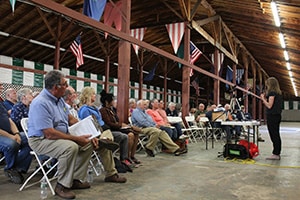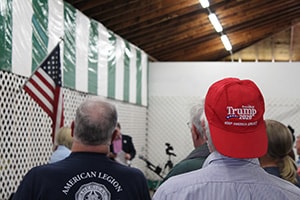By Ethan Weinstein
Critical Race Theory (CRT) has sparked partisan fury across the nation in recent months. Now, those debates have come to Rutland.

Dozens gathered at the Vermont State Fairgrounds to listen to presenters discuss the harm of teaching Critical Race Theory.
Roughly 70 people met at the Vermont State Fairgrounds in Rutland Wednesday night, June 16, to discuss the presence of CRT in school curricula and what they perceive as the theory’s toxic influence.
Although ostensibly focusing on CRT, topics at Rutland’s gathering ranged from the Black Lives Matter movement to vaccine mandates. The event, hosted by Vermonters for Vermont, featured six speakers, including Essex-Westford School Board member Elizabeth Cady, former Republican Gubernatorial candidate John Klar, and Rutland School Board Commissioner Tricia O’Connor.
In recent months, states including Arkansas, Idaho, Oklahoma and Florida have banned the teaching of CRT in public schools. CRT entered public discourse more widely after the killing of unarmed black people sparked country-wide protests last summer. More recently, the New York Times’ 1619 project garnered fury from the Right, catalyzing a movement to reimagine teachings about race and equity in K-12 education.
The night at the Fairgrounds began with the recitation of the Pledge of Allegiance, followed by the singing of “God Bless America.” Organizer Gregory Thayer then addressed the crowd. “You should be very, very proud of yourselves for being here,” he said.
“If you don’t support critical race theory, that doesn’t make you a racist, it makes you extremely unracist,” said Cady, the night’s first speaker. Earlier this month, Cady was the only dissenting vote when the Essex-Westford School Board voted to adopt a new equity policy.
Those present expressed fear that CRT would infringe upon free speech. Speakers called for a return of liberal values, saying that proponents of CRT have attempted to “Trojan-horse” its teachings into curricula without public approval.
Several speakers referenced Dr. Martin Luther King Jr.’s famous desire for his kids to be judged not by the color of their skin but the content of their character, a sentiment that these speakers felt CRT undermines.
“I embrace the teachings of Martin Luther King,” Klar said. “That makes me now a racist.”
“Based purely on race, [supporters of CRT] are prepared to shift resources from one group to another,” said Todd Filmore, the grandfather of a child in the Mill River Unified Union School District. This, he said, is the definition of racism.
As one of the whitest states in the country, some felt that CRT and education focusing on racial oppression is irrelevant to Vermont’s students and causes them to negatively view their own country and identity.

Attendees rise for the singing of “God Bless America” at the beginning of the rally, June 16.
For Klar, Vermont’s whiteness is a fact, not a problem that requires resolution. “Most of my black friends say ‘I don’t want to live somewhere that cold’,” he said to murmurs of agreement. “Why is George Floyd so relevant to Vermont?”
Martha Haftner, a former teacher from Randolph, attended the discussion because she felt that education regarding race has strayed from best practices. “I feel very much that the way to connect the races is not through different functions that are going to wave a flame on atrocities that happened some time in the past, but, as has been shown in some of the settings that were shared here, it’s fanning the flames of love and acceptance of everybody, and helping each person to grow to their capacities.”
Others attended the meeting to meet likeminded citizens.
Bennington resident Kevin Hoyt made the trip “to network and meet with some other conservative-minded people who are sick of this crap.”
Hoyt ran for governor as an independent last fall, focusing his campaign on gun rights advocacy.
The night’s speakers addressed CRT from all angles — as lawmakers, as School Board members, as concerned parents and grandparents. Audible gasps escaped the crowd as state Rep. Art Peterson, R-Rutland-2, read from Act 1, a law from 2019 targeting racism in schools. Some jeered as Klar described the poetry of Rajnii Eddins, whose poetry will soon be taught in some Vermont schools.
Ultimately, the event sought to raise consciousness. As for instrumental change, time will tell the evening’s effects on public education.



